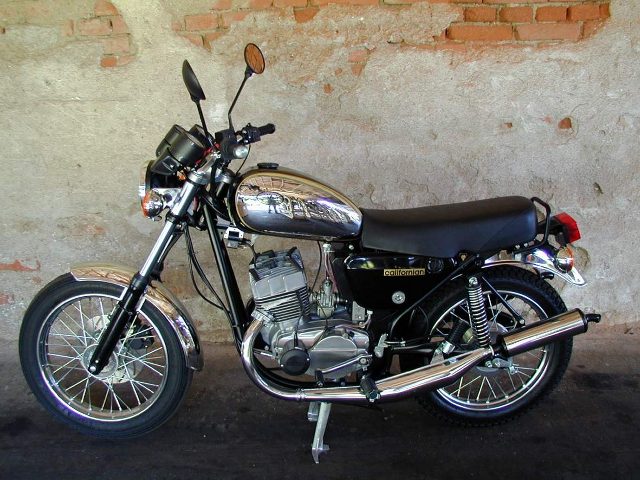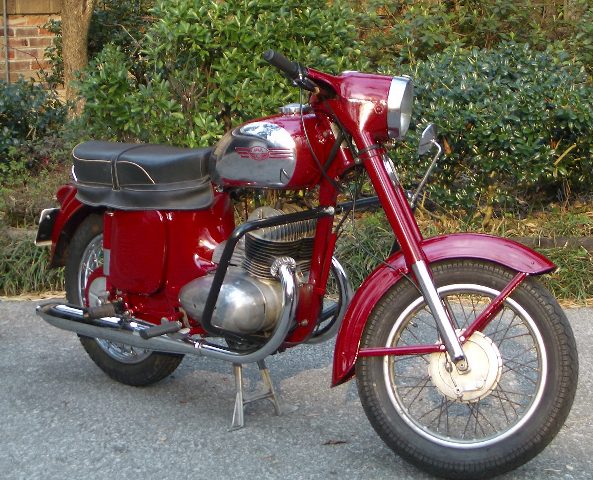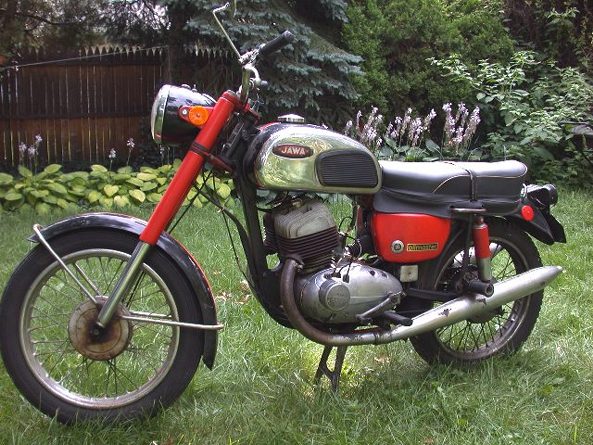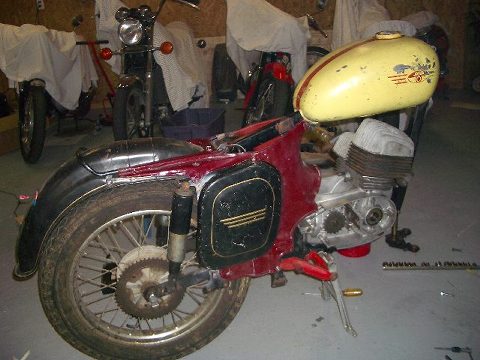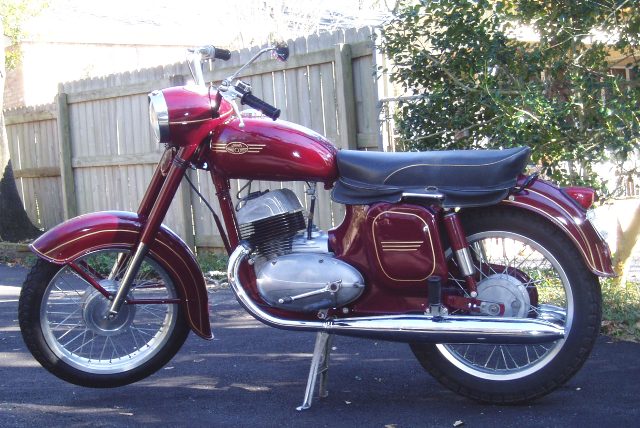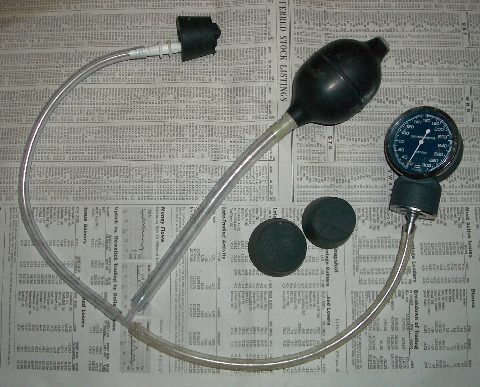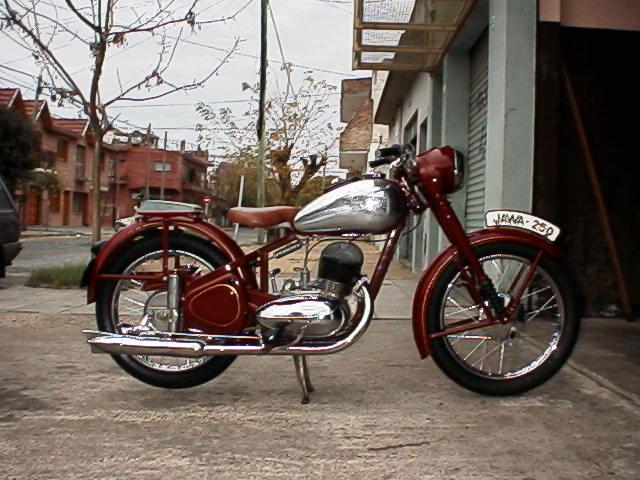The JAWA Project
A year ago I offered to help Mike Thomason get his 350cc JAWA back on the road. It had suffered a holed piston and he had gotten the cylinders rebored and had purchased oversized pistons to fit it. A friend had offered to help put it back together but due to ill health had not been able to do it. I told him to bring it over and we quickly got it going. The bike looked rough but ran good. On a subsequent ride Mike broke off a foot peg and I again offered to help. To repair the foot peg we had to pull the engine. While the engine was out I said now is the time to give it a repaint so we totally dismantled and repainted it. Several months later he had a beautiful 354 JAWA. During this project Mike said that he thought he had enough parts to build another 350cc JAWA and if I was interested he would give them to me. That is how I got into the JAWA business.
|
|
Mike Thomason's 350cc JAWA model 360. Since this picture was taken he has had pin stripes added by a professional painter. |
|
|
A JAWA 362 from 1969. Note the oil pump on the primary cover. |
The pile of parts was mostly from a JAWA 362 Californian. The 362 came out in 1969 and was designed to compete with the new Japanese models. The engine sported an oil pump and upswept mufflers. Gone were the tool boxes and the streamlined rear fairing being replaced by Japanese-style battery cover and oil tank. The tear drop tank was replaced by a square breadbox affair and a clip on headlight replaced the beautiful JAWA nacelle. There were two problems. First, Mike did not have all of the 362’s sheet metal but he had tons of 354 sheet metal. Secondly, I really wanted a 354 because I thought they looked much better than the Japanese-esque, 362. A close look at the 362’s frame revealed that it was identical to that of the 354 except for the muffler holders which were 3.25” shorter to lift the upswept mufflers. The front forks were also identical between the two models and a 354 nacelle bolted right on to it. The 362 wheels were 18” rather than 16” on the 354 but the rear fenders were identical save a small extension welded into the 362’s to accommodate the longer wheelbase.
|
|
A real kit-bike. There actually is a complete motorcycle here. |
|
|
The Muffler hangers were extended 3.25" and two 6mm bolts were welded to the hangers to hold the tool boxes. |
|
|
To make sure everything was going to fit the parts were pieced together. The motor is an empty crankcase at this point. Note the extension in the top of the rear mudguard for the long wheel base chassis. |
The figure above shows the modified muffler holders. A 3.25” section of tubing was welded into the holders to extend them and mounting hardware for the tool boxes were welded in place. To make sure everything would fit I did a trial build before I painted the parts. Unfortunately the tank was badly dented making chrome plating impossible. I simply used bondo to fill the dents and painted it solid red. I used gold paint to fill the JAWA logo stamped in the tank. Not exactly correct but still looked good
|
A good source of spares
for Jawas is Jan Jelinek’s store at www.jawaparts.com
located in the Czech Republic. The web site has a wide range of parts for
these early machines each with a picture and a price. He ships
world-wide. |
A view of the motor showing the transmission and the left crankcase half. The slot in the case allows the rods to be removed when the cases are split. When the two halves are bolted together the slot is filled by an aluminum block which is held in place by a long bolt that passes through the track in the casting. |
||
|
|
The JAWA is going back together. The paint is base coat/clear coat with polyurethane hardener. The pinstripes are 1/8" gold tape applied prior to the clear coat. The handlebars are Italian. |
The engine had its own issues. Mike had acquired the bike because it had knocking rods. A tear down indeed revealed worn out big end bearings. That meant new rods and crank pins. Like the 354 the crank shaft is a built up affair that is all pressed together. The rods use roller bearings on the crank pins and the rod and crank pin are replaced as a unit. Unfortunately the rods are different between the 362 and the much more common 360. While parts supply is excellent for the 354 it is not as good for the 362. I quickly found that the rod kits would be hard to find. After several weeks of searching Mike finally found a pair with Allan Cleaver in New Zealand. At this point I should mention that the Mike Thomason is heavily involved with the North American JAWA CZ register. Through the register Mike was able to locate many hard to find parts for me including the rod kits and a 362 generator and a shop manual. All JAWA owners should definitely join the Register. The project JAWA page also has some useful links. The 3 main bearings were obtained from a local bearing supply. I still find it amazing that this motorcycle built behind the iron curtain in the 1970s used standard western bearings and seals. Even the part numbers on the new bearings were the same as listed in the 1972 JAWA parts manual. Mike Porter here in Mobile pressed the crank together. Somewhere along the line a 354 primary cover had been substituted for the original. As a result my motor had no oil pump meaning that I would have to mix oil with the gasoline. The upside was that the 24hp 362 motor would look very much like the much milder 16hp 354 motor. A wolf in sheep's clothing so to speak.
|
|
The JAWA is together and running. Can you spot the differences between the 354 engine and the 362? Notice that the cylinder and head fins are much larger. Also, the exhaust does not attach with a finned nut but rather slips into the cylinder and is held with a single 6mm bolt. The 362 did not come with a carburetor cover although the case has a casting for one and a 354 cover will fit. Where is the kick start lever? The shift lever actually doubles as a kick start by pushing it in and rotating it 90 degrees. It sounds crazy but actually works quite well. Click here to see the right side. |
The motor went back together uneventfully The crankcase consists of two halves and a center bearing holder. I sealed them with gasket cement (Honda Bond). The joints are complex and I was worried about whether one or more of them might leak. After assembling the chassis and installing the engine it was finally time to start it. When I started the motor it ran but would not idle. It clearly had an air leak. Two cycle motors suck the fuel-air mixture into the crankcase when the piston moves up. When the piston comes down it forces the fuel-air mixture up through the transfer ports into the combustion chamber. If the crankcase is not completely sealed it will suck air through the leak which will cause the motor to run very lean at idle when the carburetor slide is closed and the crankcase vacuum is high. This was devastating as it looked like the bottom end would have to come apart again. The way to find a leak in a two stroke is to pressurize the motor. To do this I plugged the exhaust ports with rubber corks. I then used a pressure gauge and squeeze bulb from a cheap blood pressure kit. With the aid of another cork I was able to connect this to the carburetor flange. When I pumped air into the motor it quickly escaped with a hissing sound. A little soapy water revealed the leak was coming from the cylinder base gasket. That was good news as the cylinders are easy to remove with the engine in the frame. Sure enough the paper gasket was not thick enough to seal the uneven casting. A little Honda Bond on top of the gasket did the trick. With the cylinders replaced and the heads retorqued I was ready to test it again. This time when I pumped it up the pressure held steady with no leaks.
|
|
This is the apparatus I use to detect leaks in a 2-cycle motor. The 2 stoppers seal the exhaust ports and the stopper on the tube goes into the intake port where the carb mounts. With the spark plugs in place the motor should be completely airtight. The squeeze bulb and gauge are from a drugstore blood pressure kit. Once repaired the engine held a steady100 mmHg. |
The carburetor was obtained from a box of JAWA carburetors that Mike had and it seemed complete. When I started the motor this time it ran much better but still would not idle. At that point I suspected the carb. Comparison with another carb revealed a missing plug in the casting below the idle mixture screw. In order to drill the complex passages inside the carburetor during manufacture several holes must be drilled in the surface of the carburetor to gain access to the inside and then are later filled with plugs. Apparently one of the plugs in this carb had either erroneously been removed or simply fell out. I fabricated a new plug by taping the hole and putting a screw in it. After that the motor ran great.
JAWA motorcycles were built in Czechoslovakia. The company was started by Frantisek Janetek in Prague in 1929.Their first motorcycle was a German design called the Wanderer which they built under license. They called it the JAWA which was a contraction of Janetek and Wanderer. The name is surprising since the Czech alphabet does not have a “W”. Soon the company started designing its own motorcycles and up to the second world war made some very respectable 2 and 4 stroke bikes up to 350cc. During the war the JAWA factory was forbidden to make motorcycles but the industrious JAWA engineers were busy designing the postwar models right under their occupier's noses. Like many maufacturers they were inspired by the nifty German unit-construction DKW 2-cycle motor that eventually led to the BSA Bantam and Harley Hummer but they were aiming for a much larger displacement. They came up with the Perak which means "spring" in Czech and refered to its new telescopic front suspension. It was a 250cc 2-stroke design with unit construction and 4 speed transmission. The Perak chassis set the tone for what JAWAS would look like for the next 3 decades.
|
|
This is a picture of a 1947 Perak. Note the plunger rear suspension. The engine looks essentially like those to follow up through the 362 series except it had separate kick start and shift levers. It was replaced by the 353 in 1953. |
After the war the Czechs
found themselves behind the iron curtain but continued to make motorcycles.
With a fresh new model JAWA soon outsold most other European manufacturers who
were still struggling to get their prewar designs back in production. Brisk
sales of the 2 stroke models prompted them to make a 500cc vertical twin complete with overhead cam. Although a beautiful piece of machinery,
post-war Europe was more interested in cheap transportation and the model was
discontinued in 1958. In 1953 JAWA came up with the 353, a 2 stroke single of
250cc, and the 354 a 350cc twin cylinder version. Both essentially used the
same chassis characterized by the Triumph-like headlight nacelle and the
streamlined fairing behind the motor which holds the large toolboxes on either
side. These were slightly updated in 1962 to the model 359 for the 250cc single
followed shortly by the model 360 for the 350cc twin. The bikes looked similar
but had the long sausage type mufflers, more horsepower, and the panel type
nacelle. These inexpensive JAWAs looked good, were very reliable and gave good
performance. As a result they sold well and many were exported around the world
and even gained a following in the United States. The motorcycle was also built
under license in India where it was sold as the Yezdi.
In Turkey the weather is ideal for motorcycle riding and the 353 was a perfect
solution to the transportation needs of this emerging economy. The Turkish
government subsidized the mass importation of JAWAs. Today Turkey has a
thriving JAWA spares industry that has managed to keep these aging machines on
the road. The JAWA company is still alive today but
finds it much more difficult to compete on the world stage with the likes of
Honda and Yamaha. As a result their sales are largely confined to Eastern
Europe. The picture below shows the 350cc Californian as offered today.
